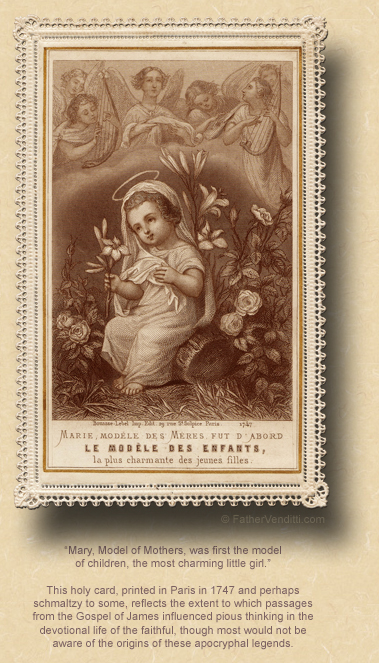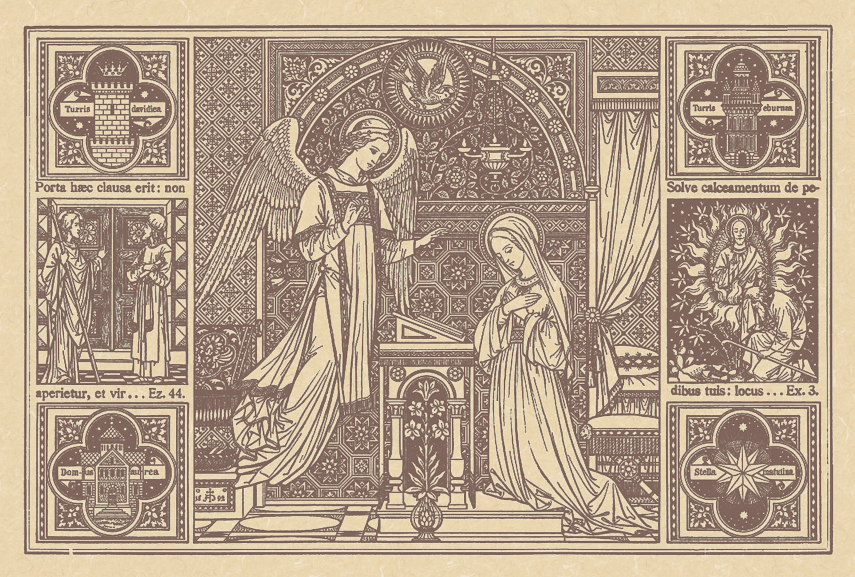The Occasional Beauties of Heresy.
The Memorial of the Presentation of the Blessed Virgin Mary.
Lessons from the proper, according to the ordinary form of the Roman Rite:
• Zechariah 2: 14-17.
• Luke 1: 46-55 (in place of the psalm).
• Matthew 12: 46-50.
The Third Class Feast of the Presentation of the Blessed Virgin Mary.
Lessons from the common, according to the extraordinary form of the Roman Rite:
• Ecclesiasticus 24: 14-16.
• Benedícta et venerábilis es …*
• Luke 11: 27-28.
The Solemn Holy Day of the Entrance of the Theotokos into the Temple.
Lessons from the menaion, according to the Ruthenian recension of the Byzantine Rite:
• Hebrews 9: 1-7.
• Luke 10: 38-42; 11: 27-28.
FatherVenditti.com
|
 10:27 AM 11/21/2015 — The presentation of the Blessed Virgin Mary is one of the most interesting—and problematic—observances on the Roman Calendar; problematic because it is not derived from Sacred Scripture: there is no account in the Bible which describes this event. It stems from a series of passages in an apocryphal gospel, the Gospel of Saint James, which was rejected as inspired by the Catholic Church, but which contains very detailed information about the childhood of both the Mother of God and our Blessed Lord. There it is said that, after an angel had revealed to Anne her pregnancy, the mother of the Blessed Virgin vowed her future child to the Lord, and brought her to the keepers of the Temple in Jerusalem to be raised there after Her birth (Protoevangel of James 7: 2). According to this apocryphal gospel, our Blessed Mother was “reared like a dove,” and received nourishment from the hands of an angel (8: 1). 10:27 AM 11/21/2015 — The presentation of the Blessed Virgin Mary is one of the most interesting—and problematic—observances on the Roman Calendar; problematic because it is not derived from Sacred Scripture: there is no account in the Bible which describes this event. It stems from a series of passages in an apocryphal gospel, the Gospel of Saint James, which was rejected as inspired by the Catholic Church, but which contains very detailed information about the childhood of both the Mother of God and our Blessed Lord. There it is said that, after an angel had revealed to Anne her pregnancy, the mother of the Blessed Virgin vowed her future child to the Lord, and brought her to the keepers of the Temple in Jerusalem to be raised there after Her birth (Protoevangel of James 7: 2). According to this apocryphal gospel, our Blessed Mother was “reared like a dove,” and received nourishment from the hands of an angel (8: 1).
Now, the Protoevangel of James was rejected by the Church as the inspired word of God because it was a Gnostic document that contained a lot that was clearly heretical, but that didn't stop the Church from drawing on some of it's more beautiful passages for inspiration, particularly in the Christian East, where today's observance is still celebrated as a Solemn Holy Day, called the Entrance of the Mother of God into the Temple. In fact, the Seminary of Saint Joseph in Yonkers, where I completed the last four years of my seminary training, had four murals behind the high altar of scenes from the life of Saint Joseph taken directly from this Gnostic document until they were painted over during the renovation that took place during my time there.
The feast of the Presentation of Our Lady was introduced in Rome in 1371, extended to the whole Church by Pope Sixtus the IV in 1472, abolished by Pius V after the Council of Trent, then reintroduced again in 1585.
Now, just to be clear, the Church rejects very firmly those passages of the so-called Gospel of James that suggest that Mary was raised in the Temple and took a vow of chastity there in childhood, simply because no such tradition existed; there was no “convent school” in the Temple of Jerusalem. This feast survives in the Latin Church as a commemoration of the consecration of the Church of the Presentation of Mary in Jerusalem. That Church was built to commemorate the commitment our Lady made to God, which must have been made since childhood as a direct consequence of her Immaculate Conception.**
 Today, what we celebrate in this memorial is the complete surrender the Blessed Virgin makes to God's plans for the salvation of the world. Her willingness to set aside whatever hopes and dreams She may have had for Her own future in favor of God's plan for Her is what made redemption possible for us; if She had said “No” when the Archangel came to Her, Christ would not have come into the world. Today, what we celebrate in this memorial is the complete surrender the Blessed Virgin makes to God's plans for the salvation of the world. Her willingness to set aside whatever hopes and dreams She may have had for Her own future in favor of God's plan for Her is what made redemption possible for us; if She had said “No” when the Archangel came to Her, Christ would not have come into the world.
That should be a sobering thought, and we should think of it whenever we realize—as everyone does at some point—that what we wanted life to be didn't quite turn out the way we had envisioned. All but the most callous could contend that Mary wasn't troubled when the Archangel came to Her with God's startling request;—the Holy Gospels say as much—and, one would have to have no heart at all to think that Mary's tears at the foot of the Cross were not real. Does anyone suppose that this is what She hoped and dreamed for Her Son? And She was “full of grace,” conceived without sin for the very purpose of supplying the human flesh in which God would become a Man. If She has to suffer all these things, She Who was conceived without sin, why would we suppose that we should have it any easier?
Today is a good opportunity—as every day is, but especially on this memorial—to renew our own dedication to God's Holy Will in the midst of our daily duties, in the specific situation in which God has placed us. If we would progress at all in the Life of Grace, imitating the docility of our Lady to the Holy Spirit is essential. Saint Josemaría Escrivá composed a prayer to ask for just this grace:
Come, Holy Spirit, enlighten my understanding to know your commandments. Strengthen my heart against the snares of the enemy. Inflame my will … I hear your voice and do not want to harden my heart and resist saying: “Later … tomorrow. 'Nunc cœpi' … Now I begin!” Now, since tomorrow may never come.
Oh Spirit of Truth and Wisdom, Spirit of Understanding and Counsel, Spirit of Joy and Peace, I fully accept whatever you desire for me, in the way and at the time that you do, simply because you so want it.***

* The Gradual in non-Scriptural: "Blessed and venerable are you, O Virgin Mary, who, with unsullied virginity, were found to be the Mother of the Savior. O Virgin, Mother of God, He Whom the whole world does not contain, becoming man, shut Himself in your womb. Alleluia, alleluia. After childbirth you remained a pure virgin, O Mother of God, intercede for us. Alleluia."
** Cf. Francis Fernandez, In Conversation with God, Scepter Press, 1993, Vol. 7, p. 267.
*** Escrivá, Postulation Articles for his Beatification and Canonization, Historical Record of the Founder, 20172, p. 145.
|

